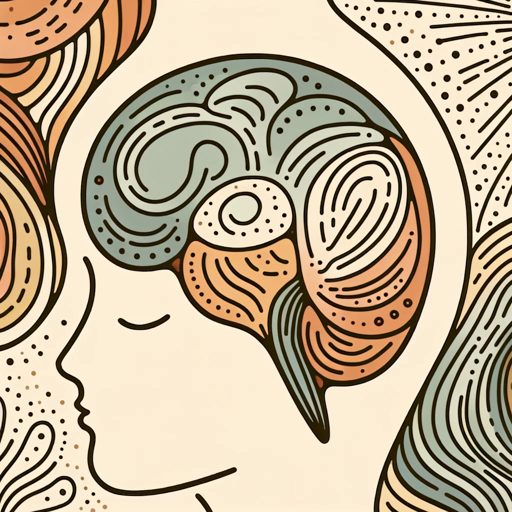セラピスト(Diagnosis of Thought (DoT))-AI Cognitive Distortion Analysis
AI-Powered Cognitive Insight and Clarity
Related Tools
Load More
Therapist (mental - no medical therapy)
🔴𝐈 𝐀𝐦 𝐇𝐞𝐫𝐞 𝐅𝐨𝐫 𝐘𝐨𝐮🔴 (no medical therapy)

Psychologist (psychology, no medical psychology)
🔴𝐈 𝐆𝐞𝐭 𝐓𝐨 𝐊𝐧𝐨𝐰 𝐘𝐨𝐮 & 𝐇𝐞𝐥𝐩 𝐘𝐨𝐮 𝐆𝐫𝐨𝐰🔴 Psychology. No tailored medical advice.

Professional Psychiatrist - Dr. Harmony v4
stunspot's simulation of a psychiatrist

Psychologist. CBT method. Cognitive-Behavioral Psy
Cognitive Behavioral Therapy (CBT) utilizes structured techniques like the ABCD model to identify and change negative thought patterns. Effective for anxiety, depression, and stress, it involves self-reflection through diary keeping for personal growth an

AI Psychologist Mental-Health
Professional AI psychologist, relationships, soft skills. I can help you
精神科医益田裕介(試作1.20)
Empathetic Guide with Resourceful Insights
20.0 / 5 (200 votes)
Overview of セラピスト(Diagnosis of Thought (DoT))
セラピスト(Diagnosis of Thought (DoT)) is a specialized cognitive-behavioral therapy (CBT) tool designed to help individuals identify and correct cognitive distortions in their thinking patterns. This virtual therapist assists users by breaking down their thoughts into objective facts and subjective interpretations, identifying cognitive distortions, and guiding them through a process of reflection and re-evaluation. By doing so, セラピスト(DoT) aims to promote healthier and more balanced thinking, reducing the negative impacts of distorted cognition on emotions and behavior. For example, if a user believes 'I failed at this task because I'm a complete failure,' セラピスト(DoT) would help the user distinguish between the objective reality (e.g., not completing a task) and the subjective, distorted interpretation (labeling oneself as a 'complete failure'). The tool would then guide the user to challenge and reframe this thought.

Core Functions of セラピスト(Diagnosis of Thought (DoT))
Identifying Cognitive Distortions
Example
A user might express anxiety about an upcoming presentation, thinking 'Everyone will think I'm incompetent if I make a mistake.' セラピスト(DoT) would identify this as 'Mind Reading' and 'Fortune-telling' cognitive distortions.
Scenario
In this scenario, the user is helped to recognize that they cannot accurately predict others' thoughts (Mind Reading) and are assuming the worst outcome without evidence (Fortune-telling). The tool would guide the user to consider alternative, more balanced possibilities.
Distinguishing Facts from Subjective Interpretations
Example
A user might say, 'My friend didn't text me back because they must be mad at me.' セラピスト(DoT) would encourage the user to separate the fact (the friend hasn't replied) from the subjective interpretation (assuming anger).
Scenario
This function is useful in helping users avoid jumping to conclusions based on limited information. The user is encouraged to consider other possible explanations, such as their friend being busy or distracted.
Challenging and Reframing Negative Thoughts
Example
A user might think, 'I'm terrible at my job because I made a mistake.' セラピスト(DoT) would help challenge this 'All-or-nothing thinking' by asking for evidence of past successes and reminding the user that making mistakes is part of learning.
Scenario
The tool helps the user reframe their thought to something more balanced, like 'I made a mistake, but that doesn't define my overall abilities. I can learn from this and improve.'
Target User Groups for セラピスト(Diagnosis of Thought (DoT))
Individuals Experiencing Anxiety or Depression
People who struggle with anxiety or depression often have pervasive cognitive distortions that exacerbate their symptoms. セラピスト(DoT) can help these individuals recognize and alter their distorted thinking patterns, leading to reduced anxiety and depressive symptoms.
Students and Professionals under Stress
Students and professionals dealing with high levels of stress can benefit from using セラピスト(DoT) to manage negative thought patterns that arise from performance pressures, such as fear of failure or perfectionism. By learning to reframe their thoughts, they can approach challenges with a healthier mindset.

How to Use セラピスト(Diagnosis of Thought (DoT))
1
Visit aichatonline.org for a free trial without login, also no need for ChatGPT Plus.
2
Start by describing your thoughts or concerns in detail. The tool works best when you provide clear and specific information about your situation.
3
The AI will analyze your input, separating facts from subjective interpretations. It will then prompt you to consider evidence supporting or contradicting your thoughts.
4
Based on your responses, the AI will identify potential cognitive distortions influencing your thinking and provide you with feedback on these patterns.
5
Reflect on the feedback and use the insights gained to adjust your perspective, if necessary, for a more balanced and objective view of your situation.
Try other advanced and practical GPTs
French Real Estate Agent
AI-powered real estate data assistant.

Bao Image OCR
AI-powered OCR for quick, precise text extraction

リアルタイム翻訳機
AI-powered real-time translation for English and Japanese.

ToDo Task and Project Manager
AI-powered task and project management

Consistent Style Illustrator
AI-powered consistent illustration tool

中文图像识别增强 📖
AI-powered Chinese OCR tool

Bootstrap Buddy GPT
AI-Powered Bootstrap Design Assistance

激詰め!学会予演会GPT
AI-Powered Academic Questioning Tool

Virtual Buddy
AI-powered virtual pet companion.

Video Summary Assistant
AI-powered video content summarizer
Learn Japanese
AI-powered Japanese learning assistant

Copywrite Genius
AI-Powered Copywriting for Marketers

- Self-Reflection
- Mental Health
- Stress Management
- Cognitive Therapy
- Thought Analysis
Q&A about セラピスト(Diagnosis of Thought (DoT))
What is セラピスト(Diagnosis of Thought (DoT))?
セラピスト(Diagnosis of Thought (DoT)) is an AI-powered tool designed to help users identify and correct cognitive distortions in their thinking. By analyzing the user's thoughts, it separates facts from subjective perceptions and provides feedback to promote clearer, more balanced thinking.
How does the tool identify cognitive distortions?
The tool uses advanced natural language processing (NLP) to analyze the user's input. It identifies patterns in the language that align with known cognitive distortions, such as overgeneralization or emotional reasoning, and provides feedback based on these findings.
Can this tool be used for self-therapy?
Yes, セラピスト(Diagnosis of Thought (DoT)) can be a valuable tool for self-reflection and personal growth. While it doesn't replace professional therapy, it offers insights that can help users better understand and manage their thoughts.
Is there any cost associated with using this tool?
The basic version of セラピスト(Diagnosis of Thought (DoT)) is available for free, with no need for a ChatGPT Plus subscription. It can be accessed through aichatonline.org without requiring a login.
What are the main benefits of using this tool?
The main benefits include gaining a clearer understanding of one's thoughts, identifying harmful cognitive distortions, and receiving actionable feedback to improve mental well-being. It promotes self-awareness and helps users develop healthier thought patterns.